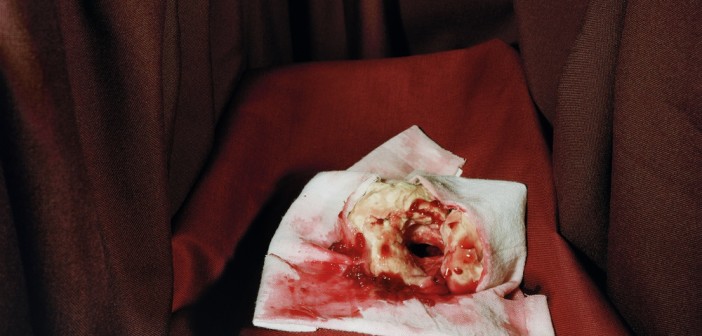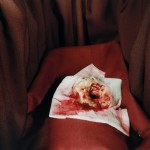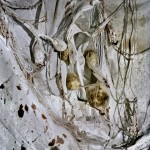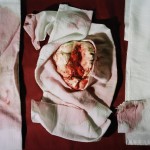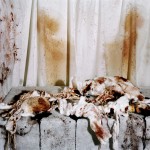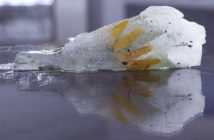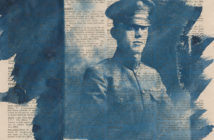 Title: "Limbic"
Title: "Limbic"Artist: Kathryn Parker Almanas
Exhibit: Pre-Existing Condition
Gallery: Yellow Peril Gallery
There are only seven photographs in the first gallery, but they pack a punch to the gut. The immediate response upon walking through the door is visceral, even overwhelming for some people. Gallery Director Vanphouthon Souvannasane is aware of their effect. He was quick to come over to greet me, jovially pointing out the artist’s statement on the wall, lest there be any confusion over just what I was confronting. Some of the images are "hard to digest," he noted. Landscapes these are not!
You may know photographer Kathryn Parker Almanas from her appearance on season two of the reality TV competition Work of Art: The Next Great Artist. I confess I have not watched the show, but I’ve heard colorful stories. It’s just the kind of thing you might expect from an artist whose work explores her digestive issues. With titles like Bloatation, Vestige, and Sever, Almanas’s photographs are as disgusting as you might suspect. But don’t get me wrong. Just because work is disgusting, that doesn’t mean it’s not good art. (Now, whether art can be good simply because it is so viscerally disgusting is another question, one I’ll leave aside.) There is no denying that Almanas’s work is provocative, eliciting emotions in viewers that are sometimes, Souvannasane informs me, too hard to take. Collectors who have recently been hospitalized, suffered illness, or lost a loved one have told him personally that they cannot purchase this work, though they might have been intensely interested in it just weeks before. It is, as her eponymous photograph indicates, "surgical theatre."
There are physical divisions within the gallery, with Parker Almanas’s photographs in a separate room than her collages, and noticeable conceptual divisions within her work. Her photographs on view are, to my eye, of two kinds: there are clean, surgical incisions and organs, bones, and tissue laid out for anatomical research, and then there are the far more disturbing, ritualistic arrangements of messy bodily matter. The former are well-lit, on folds of drapes or white towels. The latter hang loosely in strange assemblages, against backdrops that appear to be curtains splattered with bodily fluids. It is surgery and medicine, but also gore and violent crime, perhaps both at once. I mentioned this to Souvannasane, who remarked that the artist’s favorite film when she was (very) young was Silence of the Lambs. It’s no surprise, looking at her work now.
But if you keep looking closely, you’ll notice that nothing in Pre-Existing Condition is what it seems. This is what drew Souvannasane to this work, and what he hopes viewers will take time to notice. Almanas is a Yale alum who was no stranger to their medical school during the time she spent completing her MFA. There, she witnessed the dissections of cadavers. And so it came to pass one day that she happened to notice the similarities between a day-old pastry she was eating and the internal structures she had seen many times before in the lab. Working with cherries, pastries, dough, cinnamon, tapioca, and other delectables, Almanas explores the strange resemblances between body parts and food. Bloatation, for instance, is no more than tapioca in women’s tights, though it is designed to appear otherwise. Hers is intestinal art, revealing the relationship between digestion and that which is digested. The photographs are all contrived, elaborate internal stages. And they are all scrumptious food, which is perhaps the most uncanny aspect of her work. So that viewers could smell the art as much as see it, Souvannasane served pastries, dissected into slices, of course, at the opening.
 Title: "Sever"
Title: "Sever"Artist: Kathryn Parker Almanas
Exhibit: Pre-Existing Condition
Gallery: Yellow Peril Gallery
But while Almanas’s photographs are a world of dissection, her collages, just on the other side of the gallery partition, are scenes stitched together with suturing thread. They are on a smaller scale than her photos, and, arguably, more intimate in some respects. Comfortable taking apart the body, it appears the artist is just as motivated to put it back together again. Her collages combine illustrations from a 1970s nursing manual, her mother’s, as it turns out, with surgical gloves, medical bandaging, and cutouts from cooking magazines and her own photographs. There are images of healing and repair, with her series of nurse and patient collages forming a grid of absolute care-taking Chronic Care Collection. Notably, the nurse is stained with (questionable) fluids, the patient washed clean, in each picture.
As conceptually appealing as Almanas’s work might be, I am not particularly comfortable with any of it. Her collages can be as deeply unsettling, sometimes more so, than her photographs, and not simply because they call Frankenstein and his monster to mind. There are cut up reproductive organs on view here, women’s, I would add, and one triptych that is ultimately too disturbing for me to take seriously. Three Systems of a Woman: Digestive, Reproductive, Nervous is, I would imagine, satirical, a critique of the dissection of women's anatomy for use in medical "research" as illustrations (and supposed evidence) of sexist discourses. But while it might be politically correct in that sense (although I do not actually see the critique), it is nevertheless troubling for other reasons. The women are all in supine, sexual positions. I find it very difficult to look at the first image, in particular, in which a woman’s face has been replaced with what appears to be raw, rotting meat. It is the surface of an organ, no doubt, one that looks as though covered with tumors, possibly, to an untrained eye.
Sometimes it is a good thing to be offended by art; it can often make us realize our own unconscious biases or cultural taboos. But in this case, I cannot help but feel that Three Systems of a Woman is either empty shock and awe, or the evidence of some disturbance that requires deep psychoanalysis. Unfortunately, the same could be said for all of Almanas‘s work.
I don’t want to speculate about the artist’s feelings toward her mother, who was a nurse, after all. I don’t believe that pop psychology has any place in an exhibition review, and, frankly, I just don‘t want to open that can of worms. But there is something in Almanas‘s work that, intentionally or not, revolves around feelings and beliefs about women. Whether it is women’s reproductive organs sliced open, women’s troubled relationship to what has historically passed as medical science, their leggings, or the role that women traditionally play as nurses or caretakers, the underlying problematic in this artwork, which rises intensely to the surface, has somethingto do with women. I’m not sure just what it is, but I feel as certain as I do nauseated that it is there. You just cannot replace a woman’s face with innards in a way that is not hostile, not even if your work is ultimately a critique of the sexist medical gaze.
I will say outright that Surgical Theatre, like some other photographs in Pre-Existing Condition, is particularly vaginal in appearance. To be sure that this observation wasn’t merely in my own imagination (I want to be fair, after all), I solicited the opinions of others without further context. Imagine receiving a closeup of Surgical Theatre or Sever via text message! And if you look even more closely, you might notice something else that is perturbing about the former, for there appears to be something within the bloody vaginal opening that is peering right back at you. Whether intentional or not, whether present on purpose or an unfortunate accident of the camera, I confirmed that others saw it, too, before committing my observations to print. Because what it appears to be is a man's face.
It’s just not something you ever want to see. So, yes, I would be lying if I did not say I find Pre-Existing Condition to be disquieting, revolting, and grotesque. It makes me uncomfortable and uneasy, but not because I am squeamish about innards, or even because this work appears to be the result of surgical or murder scenes. It’s not that. Rather, I cannot shake the sense that there is something just under the surface in this work--some feeling, or commentary, some unconscious thought or suspicion about women--that, while I cannot fully identify it, does not sit well with me. The concept, I will grant, is fascinating: assembling concoctions of food into contrived organs, investigating digestion through that which is digested. The power of this work to evoke strong feelings without focusing beyond the body on the horrors of the world is astonishing. Along with Souvannasane, I can see a future place for Pre-Existing Condition at the ICA. And, without a doubt, I would say that you should make the trek to Yellow Peril Gallery to see this exhibition and others after it.
Souvannasane and his business partner, curator Robert P. Stack, came to Rhode Island from Brooklyn. Their enthusiasm is contagious, and they are determined to bring art to neighborhoods and communities that need it. You will surely see provocative work at Yellow Peril Gallery, for a long time to come, from emerging artists who are worth taking seriously. In 2014, Souvannasane himself will be spearheading plans for the inaugural Providence Biennial. While I am not personally over the moon about Almanas’s work, I am a huge fan of her gallery. Pre-Existing Condition, on view now through August 11, is different, eerie, thought-provoking, and powerfully evocative. You should plan to see it for that reason alone, with one caveat: it is decidedly not for those with weak stomachs.
- Title: “Surgical Theatre” Artist: Kathryn Parker Almanas Exhibit: Pre-Existing Condition Gallery: Yellow Peril Gallery
- Title: “Limbic” Artist: Kathryn Parker Almanas Exhibit: Pre-Existing Condition Gallery: Yellow Peril Gallery
- Title: “Sever” Artist: Kathryn Parker Almanas Exhibit: Pre-Existing Condition Gallery: Yellow Peril Gallery
- Title: “Vestige” Artist: Kathryn Parker Almanas Exhibit: Pre-Existing Condition Gallery: Yellow Peril Gallery

